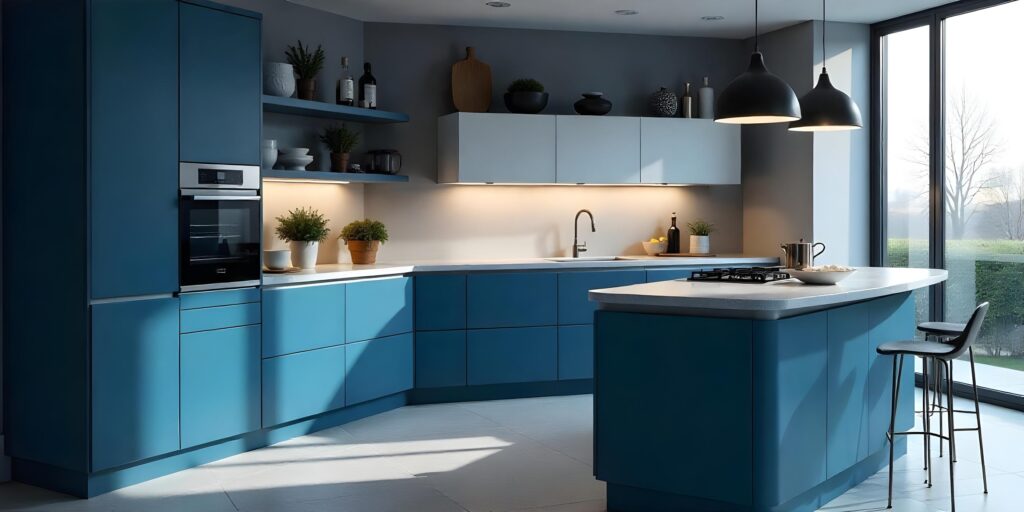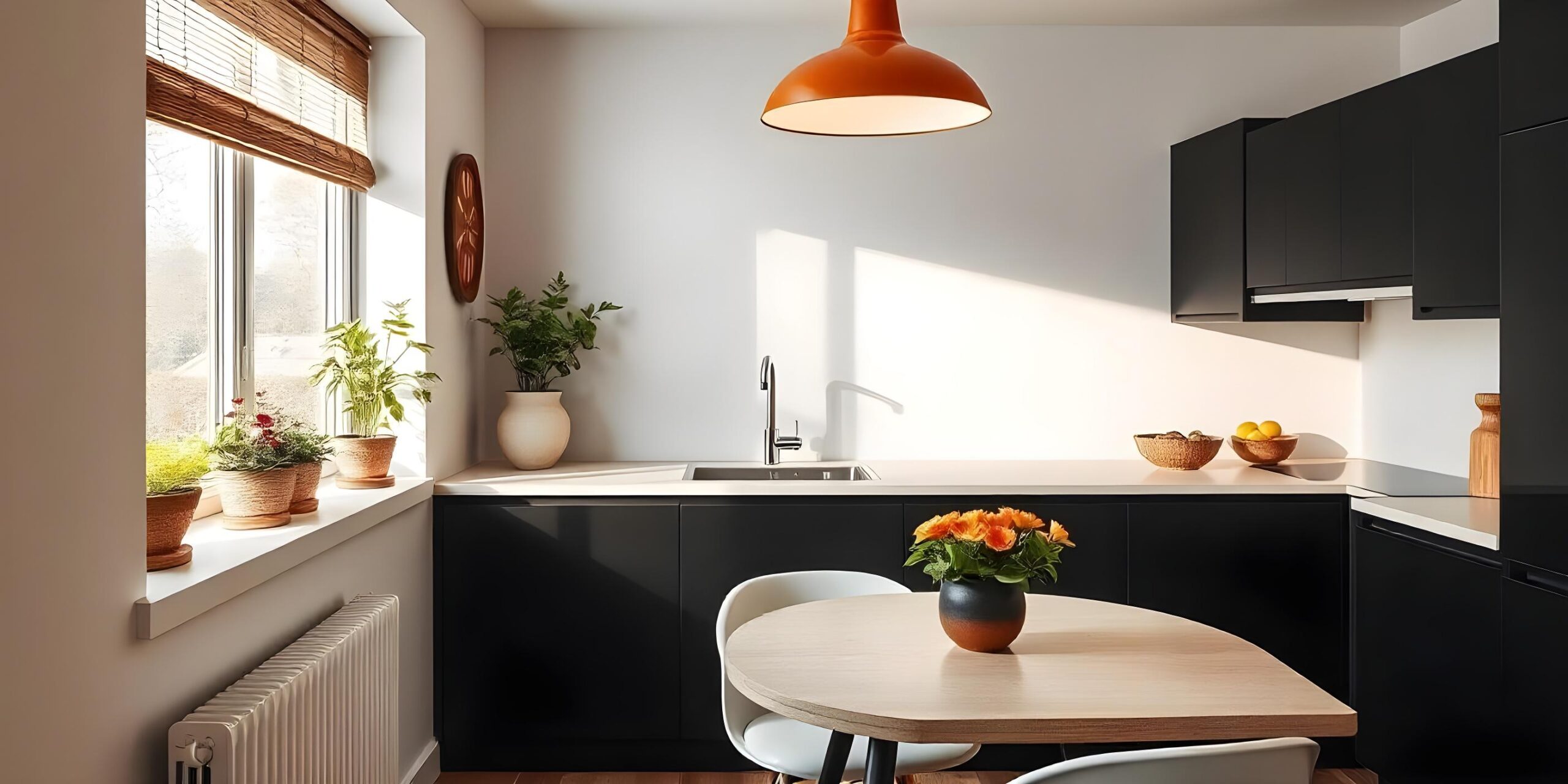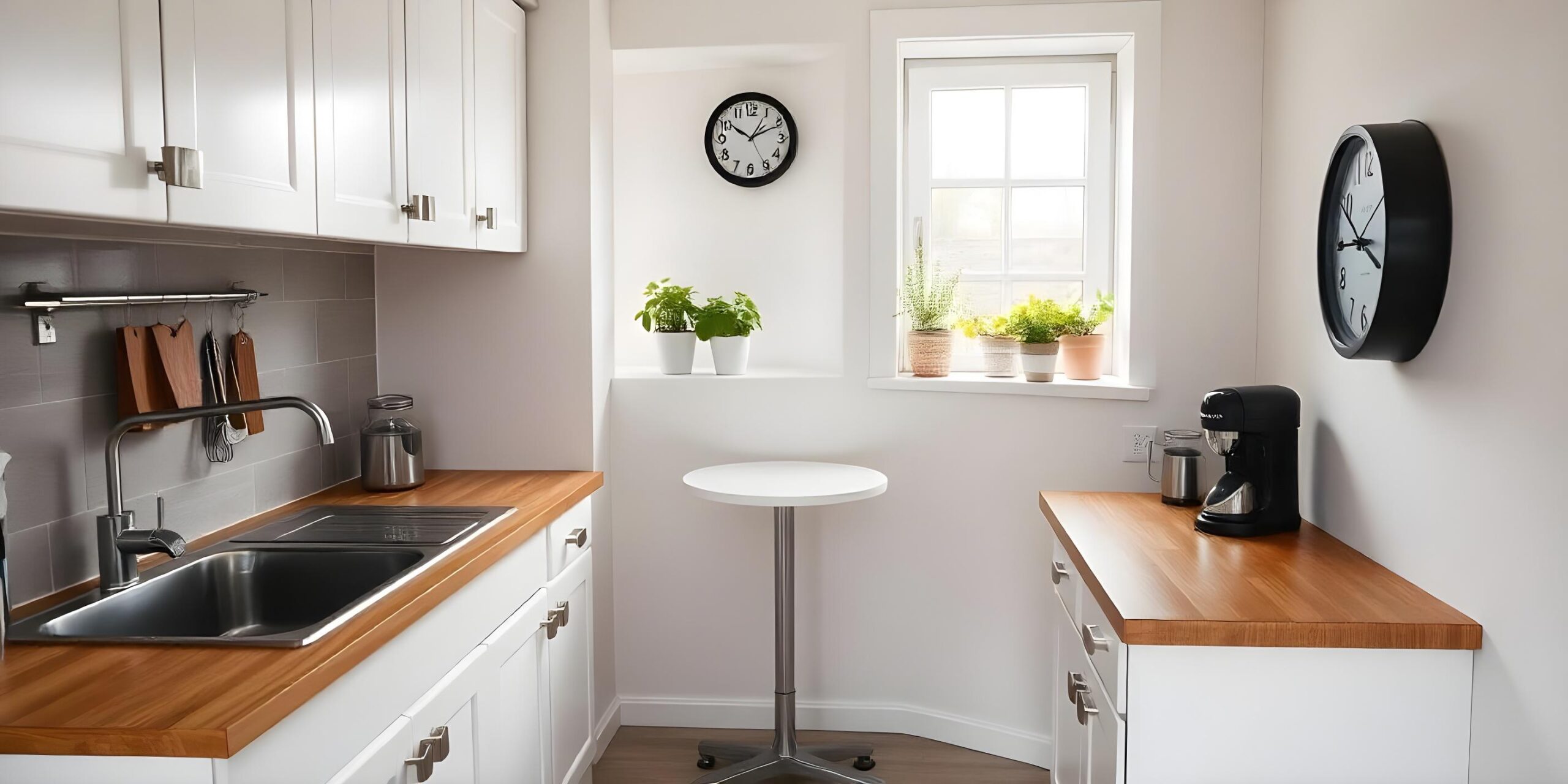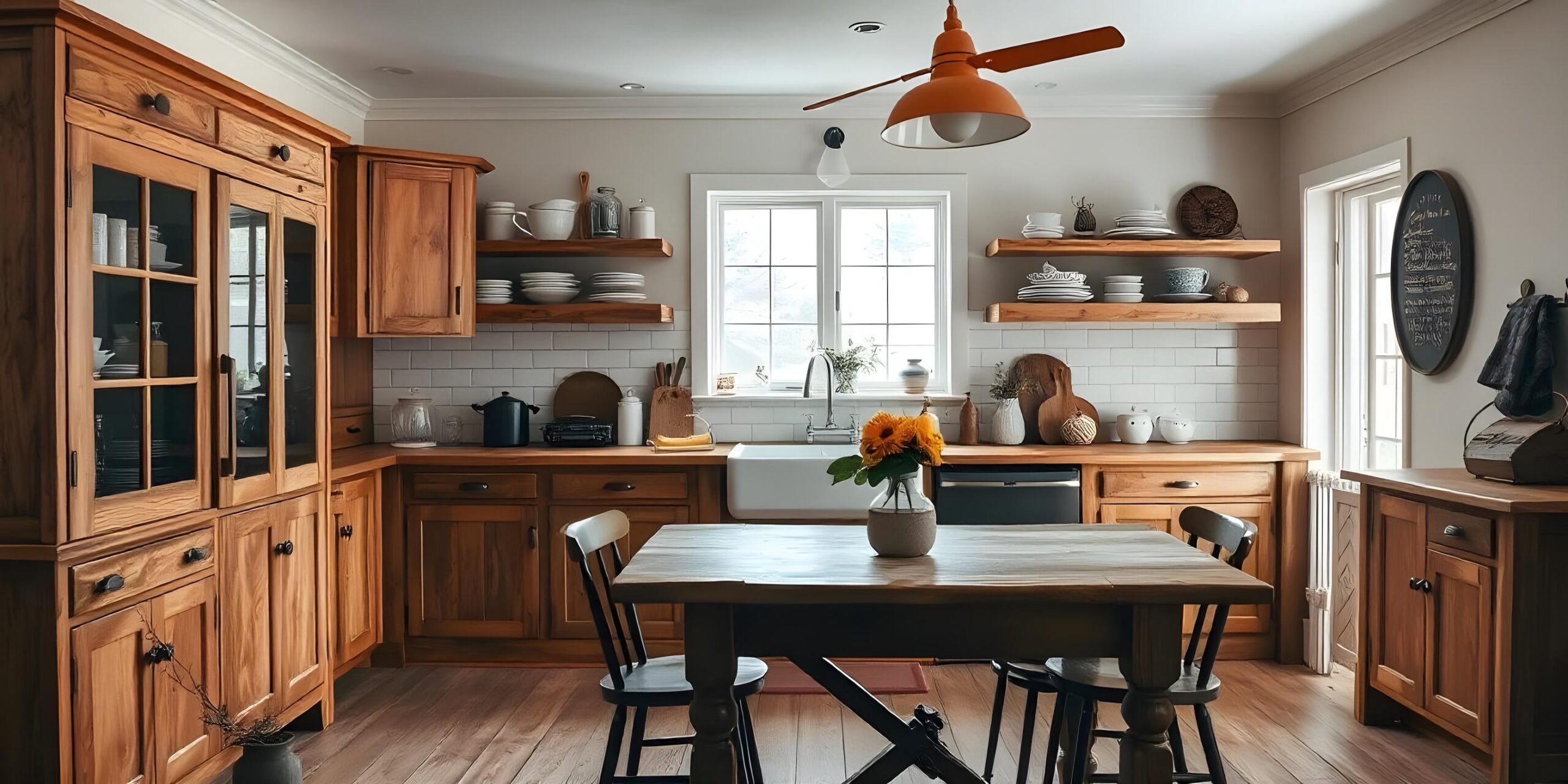Kitchen design and its psychology is something home owners can take note of before purchasing cabinets for their kitchen space. Here are some ways on how cabinets can be a huge influence at home.
Psychology Of Kitchen Design Using Materials And Textures
Kitchen cabinet material and textures are a silent, strong contributor in setting up the tone and ambience in an area. For instance, wood cabinetries establish an environment of warmth that, in one way, takes someone near nature with so much comfort and flashes of past moments. Natural patterns and shades of soil or wood relax the soul, soothing the mind amidst this busy space called a kitchen.
On the other hand, high-gloss or lacquered finishes are sleek and modern-looking, reflecting light to brighten the space and creating an impression of cleanliness and luxury. These finishes are often associated with sophistication and can energise the space with a contemporary vibe. Meanwhile, matte finishes are for those who enjoy the grounded and understated feeling. Light is absorbed and glare minimised by the soft, mellow look that can even be described as calming and relaxing.
Textured elements like reclaimed wood or cabinets with great details, bring depth and character to the kitchen and may evoke a sense of authenticity and creativity. Smoothing surfaces like stainless steel, speak of effectiveness and preciseness — these features are perfect for someone that believes in functionality and a straightforward working process.
Finally, material and texture express each one's personality because a decision taken shows personal taste but also an inner demand. From warmth to serenity and modern sophistication, kitchen cabinets are sure to evoke your mood with the right combination of materials and texture to enhance the overall experience in the kitchen.
Psychology Of Kitchen Design Via Organisation And Storage

Organisational and storage features of the kitchen cabinets have much to do with your mood — this is because such conditions in the kitchen speak a lot about your mood. A well-organised kitchen allows you to feel in control and efficient, reducing stress and therefore providing space for a productive, positive atmosphere.
Cabinets with smart storage solutions like pull-out shelves, adjustable dividers or even built-in organisers can eliminate clutter and let items be found and accessed easily. Not only does this enhance functionality but it also contributes to a visually clean and harmonious space that is important for mental clarity. On the other hand, a disorganised or cluttered cabinet will lead to frustration and feelings of being overwhelmed, especially in the busy kitchen where every minute counts. The psychological effect of a neat and organised kitchen is a feeling of calm and accomplishment since every tool and ingredient has its place.
@ampquartzcabinets Siapa yang tengah merancang untuk buat kabinet dapur simple, estetik dengan bajet sederhana… boleh PM kita! Promosi hanya untuk bulan Disember 2024! Jangan terlepas🫡 #kabinetdapurmurah #johorbahru #drykitchen #dapurminimalis #ampquartz
♬ original sound – Giri🗻 – Giri🗻
Open shelving and fronted glass cabinets, as used judiciously, would enable thoughtful display organisation of visually appealing items and add personal touches, invitingly. Furthermore, it would introduce hidden storage such as toe-kick drawers or corner pull-outs-along the cabinetry, making efficient use of room without sacrificing design and ensuring a place for everything to remain out of sight.
Well-planned cabinetry is what will make the kitchen a haven of order and creativity, both mood and productivity-enhancing. By addressing storage needs with intention, cabinets elevate not only the functionality of the kitchen but also its emotional resonance as the heart of the home.
Psychology Of Kitchen Design With Customisation And Personalisation
Customisation and personalisation of kitchen cabinets have a big impact on your mood by creating individuality and comfort in the space. The tailored designs enable you to create a kitchen that resonates with your personality and way of life. For instance, choosing custom colours that evoke positive feelings such as soothing blues, energising yellows or warm natural wood tones can turn it into your own haven.
Artistic handles or engraved panels evoke a sense of pride and ownership that will take one's kitchen to its most joyful and inspiring ambiance. Personal touches in the form of display cabinets for cherished heirlooms or cookbooks stir a layer of sentiment and bind one closer to this place. Functionality also plays a very important role — custom storage solutions such as pull-out spice racks or deep drawers for pots and pans, reduce clutter and stress, making for smooth daily routines and promoting a sense of order.
More importantly, personalised integrations of lighting within the cabinetry can add ambiance, making the kitchen more inviting during different times of the day. It will also attach emotion to the space by designing cabinets that reflect both your needs and aesthetics — making the kitchen more than a place to cook, but a hub of creativity, comfort and well-being. Designing your kitchen cabinets according to your preferences and habits means you create a space that is not only beautifully looking but actually raises your mood every time you enter it.
Psychology Of Kitchen Design Based On Style

The style of design for kitchen cabinets has the strongest impact on the nature and mood of your area because it directly affects your disposition. Traditional cabinets fully detailed, with raised panels and warm wood tone-carry a sense of tradition and comfort, reminding people that the kitchen should serve as a welcoming heart to the family and its relations.
Where antique cabinets are ornate lined, high-gloss finished, minimalist in design to exude order and sophistication, speaking to those who want clarity and simplicity in everyday living that nurtures a calm and organised mindset, on the other hand, rustic or farmhouse cabinets evoke nature through natural wood grains, distressed finishes and earthy tones — creating warmth and authenticity. These designs tend to foster a cozy, grounded environment, one that is so conducive to relaxed gatherings or even reflective cooking moments.
@ampquartzcabinets Kitchen Trends 2024. Which one is your kitchen? 👀 #homeinspo #kitchen #kitchendesign #kitchentrends #interior #AMOQUARTZ
♬ Intergalactic Janet – Ley Soul
Those who love creativity and uniqueness, eclectic or bold cabinet styles with vibrant colours or unusual materials infuse energy and personality into the space, stirring inspiration and joy. Your cabinet style should be one that reflects your personality and emotional experience that you want to have inside your kitchen. Whether you are into a peaceful retreat, an energetic social hub or a no-nonsense-but-stylish workplace, your design style option has a serious effect on how you will feel and will interact in this most vital area of the home. By choosing cabinet styles with thoughtfulness, you really can create a kitchen that will be more than beautiful, it will be good for you.
Psychology Of Kitchen Design Via Colour Choices
Colour psychology does play an important role in designing your kitchen as the colour of your cabinets really depicts your mood and the essence of the space. Yellow, red and orange shades are warm-toned, energetic colours which best create a social and alive kitchen. These colours will depict warmth and cheeriness that make people converse and in turn, make the kitchen a gathering spot for all.
On the other hand, cool tones include blue, green, and grey — these colours are soothing and offer rest and balance. Blue cabinets can represent serenity while green represents freshness and nature, refreshing a kitchen. Neutral tones such as white, beige and natural wood are versatile and timeless, providing a sense of cleanliness and order. They offer a light and airy feeling that makes people more focused and clear especially where organisation is much needed. Darker hues, such as deep navy and charcoal can bring notes of sophistication and intimacy to the room but they make a small kitchen feel more enclosed.
The choice of cabinet colour would depend upon the intended mood and functionality of the kitchen. A family-oriented kitchen would feel most appropriate with warm and inviting tones while a minimalist space could easily lean toward neutrals or cool shades. By understanding the effects of colour, a home owner is able to choose cabinetry that complements not just the aesthetic of their kitchen but also their lifestyle and mood.





